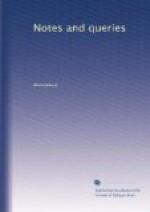“It is also described in the Oxford Architectural Society’s Manual of Mon. Brasses, No. 6. pp. 6, 7. other examples of which occur at Rochester, Kent, and at Cobham, Surrey. A small plate of brass, in the possession of a friend, has on one side a group of children, and on the reverse the uplifted hands of an earlier figure.”
And lastly, one from “A.P.H.”
(to which we cannot do ample
justice, as we do not keep
an engraver), from which we extract
the following passages:—
“A friend of mine has a shield in his possession, taken from a slab, and which has been enamelled. It is of late date and rudely executed. On the back is {371} seen the hands and breast of a small female figure, very nearly a century earlier in date. I can also remember an inscription in Cuxton Church, Kent, which was loose, and had another inscription on the back in the same manner.
“I am very much impressed with the idea that the destroyed brasses never had been used at all; but had been engraved, and then, from circumstances that of course we cannot hope to fathom, thrown on one side till the metal might be used for some other purpose. This, I think, is a more probable, as well as a more charitable explanation than the one usually given of the so-called palimpsest brasses.”]
Chapels (No. 20. p. 333.).—As to the origin of the name, will you allow me to refer Mr. Gatty to Ducange’s Glossary, where he will find much that is to his purpose.
As to its being “a legal description,” I will not undertake to give an opinion without a fee; but I will mention a fact which may assist him in forming one. I believe that fifty years ago the word Chapel was very seldom used among those who formed what was termed the “Dissenting Interest;” that is, the three “denominations” of Independents, Baptists, and Presbyterians. But I well recollect hearing, from good authority, nearly, or quite, forty years ago, that an eminent barrister (whom I might now describe as a late learned judge), who was much looked up to by the dissenters as one of their body, had particularly advised that in all trust-deeds relating to places of dissenting worship, they should be called “Chapels.” I do not know that he assigned any reason, but I know that the opinion was given, or communicated, to those who had influence; and, from my own observation, I believe that from about that time we must date the adoption of the term, which has now been long in general use.
I do not imagine that there was any idea of either assistance or opposition to the Church of England, in the mind of him who recommended, or those who adopted, the alteration, or that either of them expected or sought any thing by this measure but to obtain a greater security for property, or, rather, to avoid some real or imagined insecurity, found or supposed to attach to the form of description previously in use.




